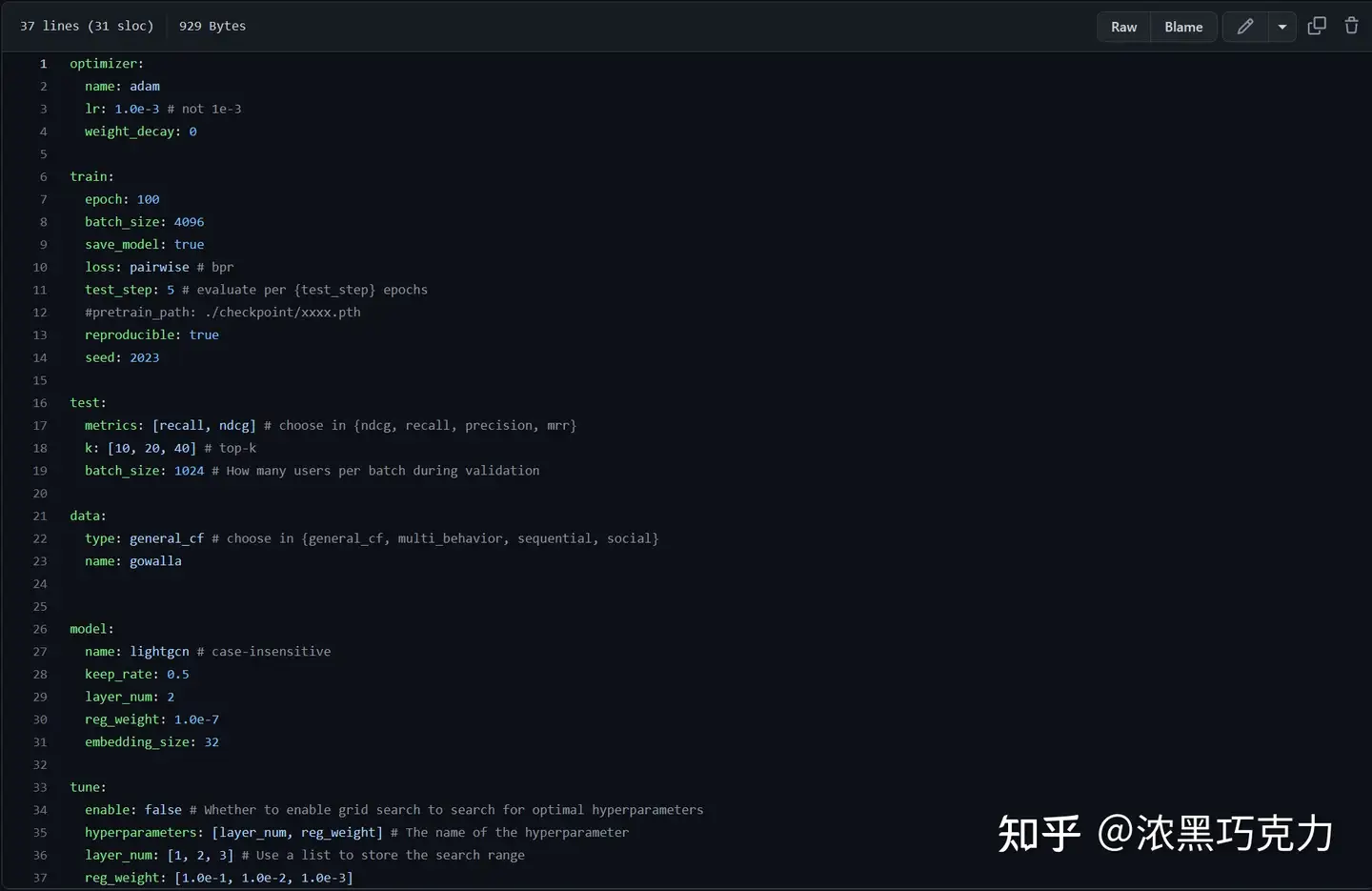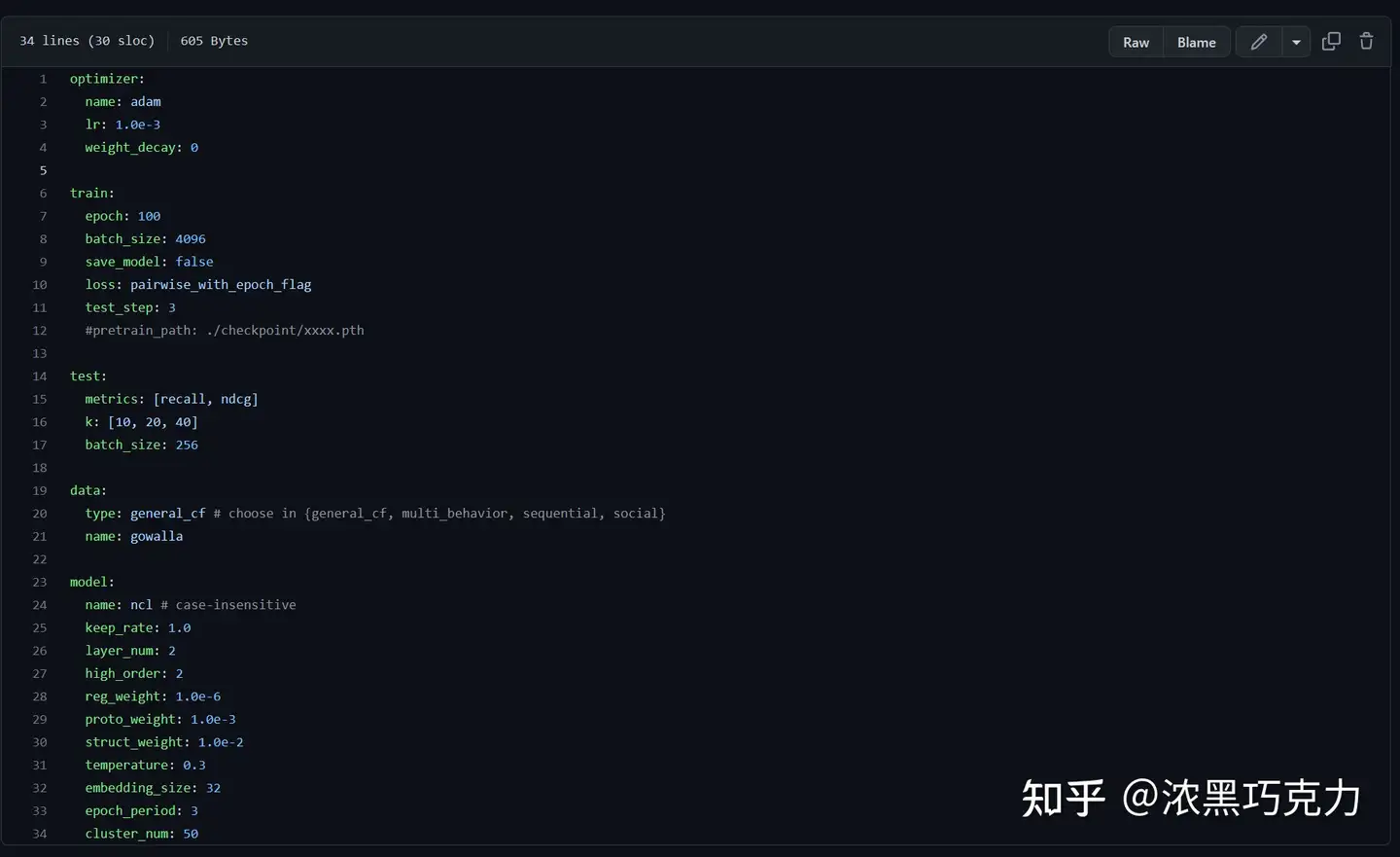![【图协同过滤】对顶会论文HCCF以及LightGCL模型的一些质疑]()
【图协同过滤】对顶会论文HCCF以及LightGCL模型的一些质疑
最近在写代码复现ICLR 2023《SIMPLE YET EFFECTIVE GRAPH CONTRASTIVE LEARNING FOR RECOMMENDATION》这篇文章,结果效果一看竟然连LightGCN还不如,更离谱的是在有些数据集上竟然发生了梯度爆炸。明明数据集一样,这怎么回事呢?我一度以为是自己的代码写错了,后来检查N遍也没发现问题在哪儿,复制过去一样的forward函数,结果却差得离谱。
最后我才发现,问题出在采样函数上,代码如下([GitHub - HKUDS/LightGCL: ICLR’2023] LightGCL: Simple Yet Effective Graph Contrastive Learning for Recommendation main.py):
1
2
3
4
5
6
7
8
9
10
11
12
13
14
15
16
17
18
19
20
21
22
23
24
25
26
27
28
29
| e_users = np.random.permutation(adj_norm.shape[0])[:epoch_user]
batch_no = int(np.ceil(epoch_user/batch_user))
epoch_loss = 0
epoch_loss_r = 0
epoch_loss_s = 0
for batch in tqdm(range(batch_no)):
start = batch*batch_user
end = min((batch+1)*batch_user,epoch_user)
batch_users = e_users[start:end]
# sample pos and neg
pos = []
neg = []
iids = set()
for i in range(len(batch_users)):
u = batch_users[i]
u_interact = train_csr[u].toarray()[0]
positive_items = np.random.permutation(np.where(u_interact==1)[0])
negative_items = np.random.permutation(np.where(u_interact==0)[0])
item_num = min(max_samp,len(positive_items))
positive_items = positive_items[:item_num]
negative_items = negative_items[:item_num]
pos.append(torch.LongTensor(positive_items).cuda(torch.device(device)))
neg.append(torch.LongTensor(negative_items).cuda(torch.device(device)))
iids = iids.union(set(positive_items))
iids = iids.union(set(negative_items))
iids = torch.LongTensor(list(iids)).cuda(torch.device(device))
uids = torch.LongTensor(batch_users).cuda(torch.device(device))
|
可以看到,模型首先对user打乱顺序(注意是打乱顺序),然后根据batch size(256)对user划分。然后,对于每一轮batch中的user,挑选min(max_samp, len(positive_items))个正样本和负样本。
乍一看好像没啥问题,对比下LightGCN的采样函数:
1
2
3
4
5
6
7
8
9
10
11
12
13
14
15
16
17
18
19
20
21
22
23
24
25
26
27
28
29
30
31
32
33
| def UniformSample_original_python(dataset):
"""
the original impliment of BPR Sampling in LightGCN
:return:
np.array
"""
total_start = time()
dataset : BasicDataset
user_num = dataset.trainDataSize
users = np.random.randint(0, dataset.n_users, user_num)
allPos = dataset.allPos
S = []
sample_time1 = 0.
sample_time2 = 0.
for i, user in enumerate(users):
start = time()
posForUser = allPos[user]
if len(posForUser) == 0:
continue
sample_time2 += time() - start
posindex = np.random.randint(0, len(posForUser))
positem = posForUser[posindex]
while True:
negitem = np.random.randint(0, dataset.m_items)
if negitem in posForUser:
continue
else:
break
S.append([user, positem, negitem])
end = time()
sample_time1 += end - start
total = time() - total_start
return np.array(S)
|
可以看到LightGCN是对user以及item同时进行了随机抽样(可重复选取),之后才根据batch size(4096)划分。我个人做实验发现这两种采样方法对模型影响巨大。前者的采样方式更容易造成过拟合。事实上作者HCCF的作者也回复我,承认采样方法存在缺陷,他认为这种缺陷是由于每个epoch过于集中关注少部分user导致的。
事实上前者的采样是一种不合理的假随机采样方法,这极易导致模型过拟合。
同样有这个问题的是SIGIR’22 的《Hypergraph Contrastive Collaborative Filtering》,采样代码如下:
1
2
3
4
5
6
7
8
9
10
11
12
13
14
15
16
17
18
19
20
21
22
23
24
25
26
27
28
29
30
31
32
33
34
35
36
37
38
39
40
41
42
43
44
45
46
47
48
49
50
51
52
53
54
55
56
57
| def sampleTrainBatch(self, batIds, labelMat):
temLabel = labelMat[batIds].toarray()
batch = len(batIds)
temlen = batch * 2 * args.sampNum
uLocs = [None] * temlen
iLocs = [None] * temlen
cur = 0
for i in range(batch):
posset = np.reshape(np.argwhere(temLabel[i]!=0), [-1])
sampNum = min(args.sampNum, len(posset))
if sampNum == 0:
poslocs = [np.random.choice(args.item)]
neglocs = [poslocs[0]]
else:
poslocs = np.random.choice(posset, sampNum)
neglocs = negSamp(temLabel[i], sampNum, args.item)
for j in range(sampNum):
posloc = poslocs[j]
negloc = neglocs[j]
uLocs[cur] = uLocs[cur+temlen//2] = batIds[i]
iLocs[cur] = posloc
iLocs[cur+temlen//2] = negloc
cur += 1
uLocs = uLocs[:cur] + uLocs[temlen//2: temlen//2 + cur]
iLocs = iLocs[:cur] + iLocs[temlen//2: temlen//2 + cur]
return uLocs, iLocs
def trainEpoch(self):
num = args.user
sfIds = np.random.permutation(num)[:args.trnNum]
epochLoss, epochPreLoss = [0] * 2
num = len(sfIds)
steps = int(np.ceil(num / args.batch))
for i in range(steps):
st = i * args.batch
ed = min((i+1) * args.batch, num)
batIds = sfIds[st: ed]
target = [self.optimizer, self.preLoss, self.regLoss, self.loss]
feed_dict = {}
uLocs, iLocs = self.sampleTrainBatch(batIds, self.handler.trnMat)
feed_dict[self.uids] = uLocs
feed_dict[self.iids] = iLocs
feed_dict[self.keepRate] = args.keepRate
res = self.sess.run(target, feed_dict=feed_dict, options=config_pb2.RunOptions(report_tensor_allocations_upon_oom=True))
preLoss, regLoss, loss = res[1:]
epochLoss += loss
epochPreLoss += preLoss
log('Step %d/%d: loss = %.2f, regLoss = %.2f ' % (i, steps, loss, regLoss), save=False, oneline=True)
ret = dict()
ret['Loss'] = epochLoss / steps
ret['preLoss'] = epochPreLoss / steps
return ret
|
可以看到,这篇文章的采样方法和LightGCL是一样的。
我注意到无论是github上还是知乎都有人说HCCF的复现效果并不好,甚至不如LightGCN。我测LightGCL也是比不过LightGCN。于是我怀疑这两篇文章都有问题。作者在回复中给了他们baseline模型测试的链接:https://github.com/HKUDS/SSLRec
结果参数一看,差别很大(SSLRec/config/modelconf at main · HKUDS/SSLRec (github.com))
首先看一下他们对LightGCN的参数设置:
![img]()
https://github.com/HKUDS/SSLRec/blob/main/config/modelconf/lightgcn.yml
首先,embedding size就给人从64削到32,layer层数从3削到2,train epoch更是直接减到100。lightGCN这种收敛很慢的模型,一般是300epoch左右才会收敛,好家伙直接给人干到100。这baseline效果不低才离谱。
再看看他们对NCL(WWW’22 《Improving Graph Collaborative Filtering with Neighborhood-enriched Contrastive Learning》)的设置,差距就更大了。我放下原模型和他们测试的参数设置,大家可以对比一下。
![img]()
NCL源代码 https://github.com/RUCAIBox/NCL/blob/master/properties/NCL.yaml
![img]()
HCCF作者给的baseline测试设置,https://github.com/HKUDS/SSLRec/blob/main/config/modelconf/ncl.yml
参数差的最大的都5个数量级了。我针对这个问题给作者发了邮件,作者回答如下:
![img]()
作者个人隐私信息未截图
实际上LightGCL embedding=64和layer=3的情况我也测试过,效果依旧不如LightGCN。希望各位看A会论文的时候擦亮双眼,该好好复现还得好好复现,而且最好自己手写,不然掉了坑也不明白咋回事。





